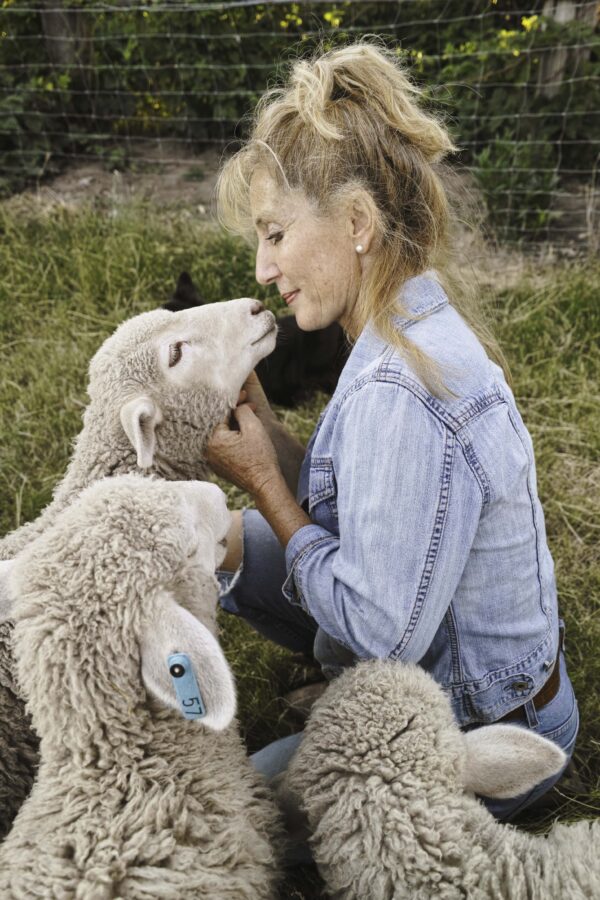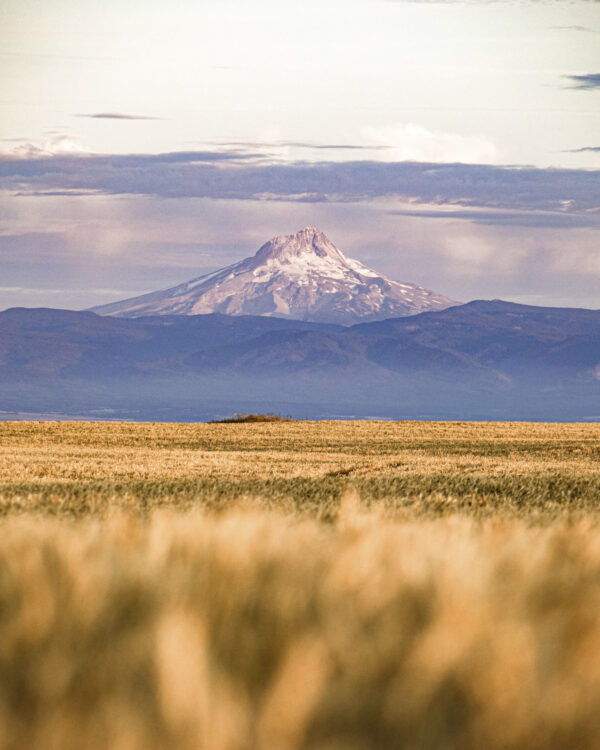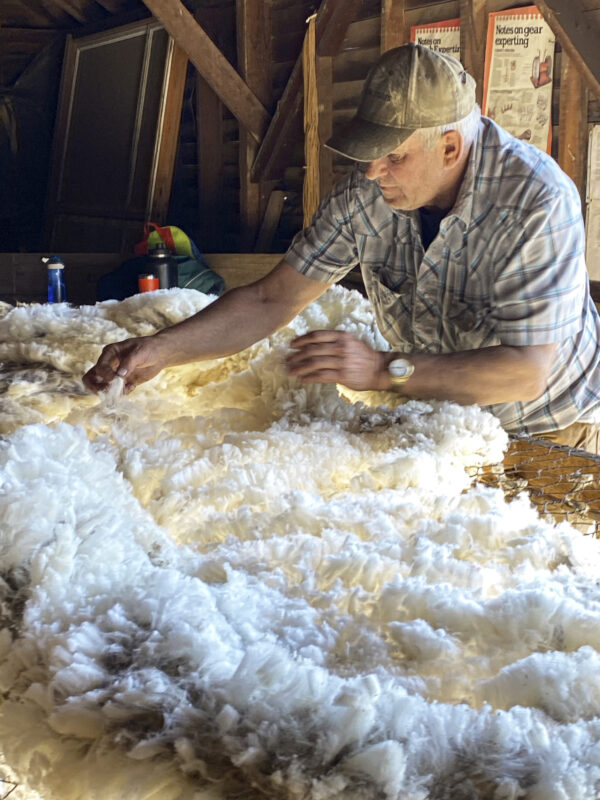How an Oregon Sheep Ranch Is Carrying on the Heritage of American Wool—and Shepherding It Into the Future

“As discussed below, planned, moderate rotational grazing and restricted soil disturbance on Western sheep ranches have aided the recovery of bunchgrass and fended off cheatgrass, the interior West’s most troublesome invasive species.
NOTE: this article was originally published to TheEpochTimes.com on November 18, 2022. It was written by Eric Lucas.
At first glance, it’s just an ordinary tussock of grass.
Shimmering, graceful, silver-gold grass, dancing lightly in the summer breeze—but grass nonetheless. Yet sheep rancher Jeanne Carver’s fond regard for this 18-inch tuft at Imperial Stock Ranch, outside Shaniko in north-central Oregon, illustrates an idea that she hopes will transform her unique corner of agriculture: fiber production. In this case, wool from Merino sheep.
“The healthier the resources, the healthier the harvest,” she said, caressing the Columbia Basin high desert bunchgrass as if it were a rare rose. “Simple management strategies are all it takes to help the landscape immensely. And that’s what’s best for all of us—people, sheep, and wildlife.”
The small patch of ground we’re viewing along the 32,000-acre ranch’s access road has benefited from the simplest land-management technique of all: minimal disturbance. Planned, moderate rotational grazing and restricted soil disturbance have aided the recovery of bunchgrass and fended off cheatgrass, the interior West’s most troublesome invasive species. So, unimpressive though it may look to the lay observer, a healthy tussock of bunchgrass signals a healthy landscape and a subtle tale of environmental restoration.

Jeanne Carver, founder of Shaniko Wool Company and owner of Imperial Stock Ranch, is a fierce advocate for the value and heritage of wool. (Courtesy of Shaniko Wool Company)
Cleaning Up the Industry
Carver has spent a quarter-century in a corner of American agriculture that has flown beneath the radar of a public more preoccupied with food production. Textile fiber—largely from wool and cotton—has been a central facet of human civilization for millennia, but while the average thoughtful American may give careful consideration to the provenance of what’s on our dinner tables, far less attention is paid to the clothing on our bodies.
Carver has been taking the ranch’s wool harvest direct to market since 1999. That work set the stage for her involvement with a program to create a set of guidelines for wool production, which has since become the Responsible Wool Standard (RWS). This consists of a set of sheep-raising and fiber-handling criteria under the aegis of Textile Exchange (TE), a global nonprofit based in Texas. RWS’s criteria focus on land stewardship, humane animal treatment, workplace fairness, and overall accountability.
These same objectives underlie TE’s campaign to bring sustainability to many corners of the fiber industry, covering cotton, alpaca, mohair, wool, down, and recycled content.
“Our goal is to help the industry achieve a 45 percent reduction in the greenhouse gas emissions that come from producing fibers and raw materials by 2030,” explained Pe-Jae Brooks of TE. The 20-year-old organization has about 750 members, ranging from ranchers such as Carver, to textile mills, to end users such as Levi Strauss and Lululemon. “For real change to happen, everyone needs a clear path to positive impact.”

Grasslands at Imperial Stock Ranch, with Mount Hood in the background. (Courtesy of Shaniko Wool Company)
Carver and TE are activists in an industry that, since the mid-20th century, has veered sharply toward synthetic fibers—largely hydrocarbon-based. According to TE, 62 percent of modern textiles are chemical rather than natural, with oil-based polyester by far the most common at 57 million tons—52 percent of total global fiber production, what Carver calls “a global trail of products with oil on it just so you can get a shirt.”
By comparison, the 24 million pounds (12,000 tons) of wool produced in the United States by about 3.3 million sheep is a drop in the bucket. But Carver believes RWS can be exemplary, if not universal, and she is a fierce advocate for the value and heritage of wool.
“Take sheep and add water—that simple formula has clothed and fed humankind for more than 10,000 years,” she declared. “Wool is a miracle fiber; sheep give all that and ask for nothing except humane care and land to graze.”
Carrying on a Legacy
Shaniko and Imperial Stock Ranch exemplify that heritage. At the turn of the 20th century, the town earned the moniker “Wool Capital of the World”—its still-standing warehouse held 4 million pounds of wool, and in 1903, Columbia Southern Railway cars hauled away 2,000 tons of wool. The town’s long decline began when the railway curtailed operations in the 1930s and ceased in 1966. Today, Shaniko is listed on Visit Oregon’s web page devoted to ghost towns.
Meanwhile, Imperial Stock Ranch was homesteaded by Richard Hinton in 1871, and at one point, it was the state’s largest individually-owned land and livestock operation, carrying more than 35,000 sheep. After several ownership changes, the ranch is now smaller. But Carver serves as unofficial steward of a ranch headquarters with an early-20th-century manor house, a historic sheep-shearing shed, and a massive barn whose evocative tack room holds dozens of priceless heritage saddles, still on saddle racks and ready to go as if a crew of ranch hands were expected tomorrow to start the fall roundup.
After taking a couple years off to care for her husband Dan in his final years enduring a fatal neurologic disease, Carver no longer manages sheep directly. Instead, she leads Shaniko Wool Company (SWC), an enterprise that includes nine family-run sheep ranches in the West, all of which are committed to sustainable production practices. SWC ranchers collectively manage 36,000 sheep on 2 million acres.
“To be honest, most of the RWS standards represent things I was already doing,” said Ted Borda, a retired teacher who took over his father’s sheep operation in Carson Valley, Nevada. “In ranching, like teaching, you’re always looking for a better way to do something.”

A worker skirts a fleece, the process of removing debris from the raw wool after shearing. (Courtesy of Shaniko Wool Company)
Borda’s “better way,” on the 150,000 acres of federal land that he leases for grazing, includes a vastly reduced herd size—he runs 4,500 sheep where his dad had grazed almost 100,000. He has adopted more humane methods of marking and castrating the animals, and he is especially proud of the housing that he provides his herders: a crew of 11, comprising two Mexican extended families who come to Nevada on agricultural H-2A visas. In six months, Borda reported, his herders make as much as they would in two years back home. And the sheepherder wagons that he provides have solar power, refrigerators, and other modern comforts unimaginable a century ago in the Mountain West, where Basque sheepherders spent months alone in the high country with only herd dogs for companions.
“It’s still a pretty solitary occupation, but they’re up there chatting on cell phones these days; no more reading by kerosene lanterns,” Borda said. “If your herders are happy, your sheep are happy. That was my father’s maxim, and he was right.”
Borda’s sheep produce about 10 pounds of wool each. Funneled through SWC, it winds up at progressive materials handlers, such as Meridian Specialty Yarn Group in North Carolina, where it is spun into RWS-labeled yarn.
“We’re looking forward to working with apparel manufacturers in North America looking for a reliable source of wool yarn, as well as products with an authentic sustainability story that they can weave into the marketing stories for their products,” explained Stephen Hudson, Meridian’s senior vice-president of sales and marketing.
That need for an authentic, U.S.-based source story is what brought Ralph Lauren to Imperial Stock Ranch a decade ago after an imbroglio over the fact that Ralph Lauren’s U.S. Olympic team uniforms were made in China. Three Winter Olympics since have featured sweaters designed and made by Ralph Lauren using Carver’s wool. Other clients have included Patagonia and Los Angeles specialty designer Janessa Leone, who places special emphasis on sustainability in her garment designs.
“There is an amazing harmony that comes through the partnerships of animals, plants, land, and place in this holistic management approach that contributes to healing of the whole ecosystem,” said Leone.

Olympic ice dancers Alex and Maia Shibutani wear Team USA’s 2018 Winter Olympics closing ceremony uniforms, designed and made by Ralph Lauren, including hats and sweaters using Shaniko wool. (Courtesy of Shaniko Wool Company)
Positive Change
Carver credits the original vision of sustainable wool production to her husband, Dan, an engineer who took over Imperial Stock Ranch in 1988 and immediately began improving both grazing practices and grain production. Among other projects, the Carvers eventually created more than 100 water catchment basins in the uplands of the ranch property outside Shaniko, north of Bend, helping to hold water into the summer, improve riparian habitats for wildlife, and, not incidentally, provide water for their sheep.
A small stream on the ranch feeds into the Deschutes River, a major Columbia River tributary. Once upon a time, before it was dammed for power, irrigation, and shipping, the Columbia saw up to 20 million salmonids return every year from the North Pacific. Now, it’s barely a half-million in a good year. “In 1990, Buck Hollow Creek saw just two steelhead return to spawn,” Carver recalled. But after the Carvers and their neighbors made sustainable changes along the stream, dozens of anadromous fish now return each summer and fall.
While healthy salmon runs are considered a prime indicator for environmental stewardship, Carver isn’t resting on those laurels. She’s hired scientific experts to determine the ranch’s carbon footprint, and she happily reports that the net carbon budget is positive, banking an additional 51,000 tons of carbon into the soil each year. She’s extending this research across all ranches in SWC. Imagine, she declared, if that could be achieved across the U.S. wool industry.
And never mind carbon banking, she added. Just consider the spiritual ethos of sheep ranching.
“To me, there’s no better picture of peace and contentment than sheep at rest, and that’s the picture you have if your sheep are not hungry, experiencing no internal stress, and experiencing no external stress.
“They remind me every day that we are all called to honor what we have been given.”
This article was originally published in American Essence magazine.
—
For more posts like this, in your inbox weekly – sign up for the Restoring Diversity Newsletter
